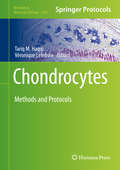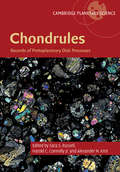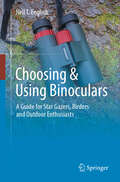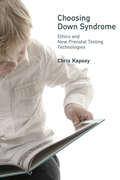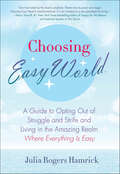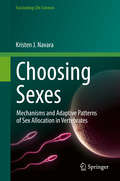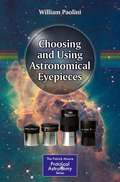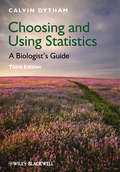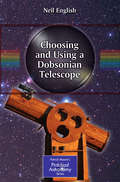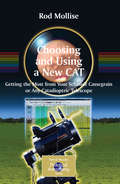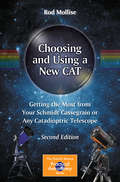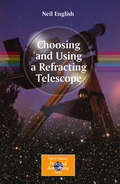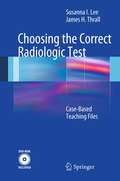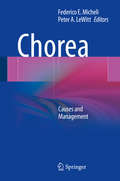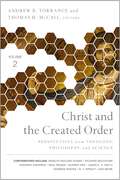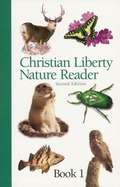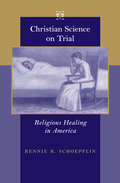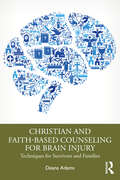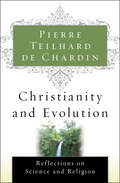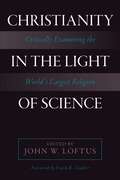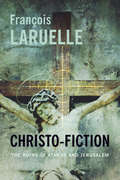- Table View
- List View
Chomp: A Shark Romp
by Michael PaulDive in to the depths of the ocean to discover different species of sharks in this nonfiction picture book with simple text and illustrations.Many different kinds of sharks are swimming below the ocean's surface.Some sharks are gentle, and some sharks are fierce. Some are awake in the day, and some are awake at night. Some eat almost anything, and some are very picky.You may not be able to visit their watery world, but you can always visit them up close at the aquarium.Simple text and bold illustrations take young explorers on a deep dive through the ocean full of sharks.Don't Miss More from Michael Paul in Roar: A Dinosaur Tour!
Chondrocytes: Methods and Protocols (Methods in Molecular Biology #2245)
by Tariq M. Haqqi Véronique LefebvreThis detailed book collects a variety of methods from investigators at the forefront of chondrocyte biology and pathology research that they have tailored for their research projects in order to tackle the unique properties and challenges of the chondrocyte and those of its tissue matrix. Divided into three parts, the volume explores experimental models to study chondrocytes, in vivo assays, as well as methods to characterize the chondrocyte phenotype with high-throughput or discrete assays on cells maintained in vivo, just isolated from their tissue (ex vivo), or cultured in vitro. Written in the highly successful Methods in Molecular Biology series, chapters include introductions to their respective topics, lists of the necessary materials and reagents, step-by-step, readily reproducible laboratory protocols, and tips on troubleshooting and avoiding known pitfalls. Authoritative and cutting-edge, Chondrocytes: Methods and Protocols is an ideal guide for experts as well as newcomers in the cartilage field with the aim of sparking new research ideas in order to solve many of the pending mysteries regarding cartilage biology, disease mechanisms, and potential treatments.
Chondrules: Records of Protoplanetary Disk Processes (Cambridge Planetary Science #22)
by Sara S. Russell Harold C. Connolly Jr. Alexander N. KrotChondrules are spherical silicate grains which formed from protoplanetary disk material, and as such provide an important record of the conditions of the Solar System in pre-planetary times. Chondrules are a major constituent in chondritic meteorites, however despite being recognised for over 200 years, their origins remain enigmatic. This comprehensive review describes state-of-the-art research into chondrules, bringing together leading cosmochemists and astrophysicists to review the properties of chondrules and their possible formation mechanisms based on careful observations of their chemistry, mineralogy, petrology and isotopic composition. Current and upcoming space missions returning material from chondritic asteroids and cometary bodies has invigorated research in this field, leading to new models and observations, and providing new insight into the conditions and timescales of the solar protoplanetary disk. Presenting the most recent advances, this book is an invaluable reference for researchers and graduate students interested in meteorites, asteroids, planetary accretion and solar system dynamics.
Choosing & Using Binoculars: A Guide for Star Gazers, Birders and Outdoor Enthusiasts
by Neil T. EnglishBinoculars are life enhancing instruments, uniquely capable of bringing the intricacies of nature into sharp focus. Whether it be birds, majestic lakes and seas, alpine vistas, wild animals or exploring the glories of the night sky, anyone interested in buying binoculars today will be faced with a bewildering number of different models to choose from! This book walks the reader through the fascinating world of binoculars, past and present, while exploring all of the main binocular types, their desirable features, how to test out and narrow down the choices a prospective customer should make, as well as looking at some of the best and most-sought-after binoculars money can buy. Uniquely experienced writer and binocular enthusiast, Dr Neil English, takes the pain out of narrowing down the search for your ideal binocular, whether your budget is $50 or $5,000. Dr English explores many of the timeless beauties of the binocular world, crafted by top European and Japanese manufacturers, such as Swarovski, Zeiss, Nikon, Leica and others. Sumptuously illustrated throughout with full color images, Choosing & Using Binoculars decodes all the technical jargon without sacrificing accuracy and presents the world’s best compendium of binocular literature for the birder, hunter, inveterate traveler, nature enthusiast and star gazer. Don’t leave home without it!
Choosing Down Syndrome: Ethics and New Prenatal Testing Technologies (Basic Bioethics)
by Chris KaposyAn argument that more people should have children with Down syndrome, written from a pro-choice, disability-positive perspective.The rate at which parents choose to terminate a pregnancy when prenatal tests indicate that the fetus has Down syndrome is between 60 and 90 percent. In Choosing Down Syndrome, Chris Kaposy offers a carefully reasoned ethical argument in favor of choosing to have such a child. Arguing from a pro-choice, disability-positive perspective, Kaposy makes the case that there is a common social bias against cognitive disability that influences decisions about prenatal testing and terminating pregnancies, and that more people should resist this bias by having children with Down syndrome.Drawing on accounts by parents of children with Down syndrome, and arguing for their objectivity, Kaposy finds that these parents see themselves and their families as having benefitted from having a child with Down syndrome. To counter those who might characterize these accounts as based on self-deception or expressing adaptive preference, Kaposy cites supporting evidence, including divorce rates and observational studies showing that families including children with Down syndrome typically function well. Himself the father of a child with Down syndrome, Kaposy argues that cognitive disability associated with Down syndrome does not lead to diminished well-being. He argues further that parental expectations are influenced by neoliberal ideologies that unduly focus on the supposed diminished economic potential of a person with Down syndrome.Kaposy does not advocate restricting access to abortion or prenatal testing for Down syndrome, and he does not argue that it is ethically mandatory in all cases to give birth to a child with Down syndrome. People should be free to make important decisions based on their values. Kaposy's argument shows that it may be consistent with their values to welcome a child with Down syndrome into the family.
Choosing Easy World: A Guide to Opting Out of Struggle and Strife and Living in the Amazing Realm Where Everything Is Easy
by Julia Rogers Hamrick"Don't be fooled by this book's simplicity: therein lies its power and magic! Choosing Easy World is transformational. It is an invitation to a new paradigm for living." —Marci Shimoff, #1 New York Times bestselling author and featured teacher in The Secret Contrary to what we've believed, life does not have to be hard. And it was never intended to be! Choosing Easy World explores the concept that we can access a place where everything works out effortlessly, harmoniously, and in support of our highest possibilities for well-being. As its title implies, Choosing Easy World reveals that the key to being in this reality—in "Easy World"—is as simple and easy as choosing to be. Woven throughout with powerful personal stories of opting into Easy World with remarkable results, Choosing Easy World provides readers with inspiration, instructions, and support for doing so themselves. In this book, you will learn: • How eleven simple words can take you to Easy World • True stories of people who have used the Easy World technique to change their lives • The differences between Difficult World and Easy World • What to do when Choosing Easy World seems impossible • How to Choose Easy World even under the worst of circumstances • And many more techniques and stories using these powerful tools. Choosing Easy World not only gives you the secret to getting to this amazing alternate reality even in the most challenging of times, it teaches you how to transcend the Difficult World-addicted aspect of your mind and contains a wealth of practical, leading-edge strategies for supporting your Easy World existence. This life-transforming book is for everyone who• Is experiencing problems with finances, career, relationships, or any facet of life• Is tired of trying hard but feeling as though they're getting nowhere• Isn't experiencing joy as their usual state of being• Feels overwhelmed by their never-ending to-do list with all its shoulds and ought-tos• Is tired of doing things they're not passionate about, or even suited for, just to pay the bills.• Yearns to discover their life purpose and fulfill it• Is longing for contentment and inner peace—outer peace, too
Choosing Sexes
by Kristen J. NavaraThere is extensive evidence that vertebrates of all classes have the ability to control the sexes of the offspring they produce. Despite dramatic differences in the mechanisms by which different taxa determine the initial sex of offspring, each group has found its own way of adjusting offspring sex ratios in response to social and environmental cues. For example, stress is a well-known modulator of offspring sex in members of all groups studied to date. Food availability, and limitation in particular, is another common cue that stimulates biases in offspring sex ratios in a wide variety of species. Offspring sex can be adjusted at the primary level, which occurs prior to conception, or at the secondary level, during embryonic development. While the mechanistic pathways that ultimately result in sex ratio biases and the developmental time-points sensitive to those mechanisms likely differ among taxa, the key involvement of steroid hormones in the process of sex ratio adjustment appears to be pervasive throughout. This book reviews the systems of sex determination at play in different vertebrate groups, summarizes the evidence that members of all vertebrate taxa can facultatively adjust offspring sex, and discusses when and how these adjustments can take place.
Choosing and Using Astronomical Eyepieces (The Patrick Moore Practical Astronomy Series)
by William PaoliniA valuable reference that fills a number of niches including that of a buyer's guide, technical desk reference and observer's field guide. It documents the past market and its evolution, right up to the present day. In addition to appealing to practical astronomers - and potentially saving them money - it is useful both as a historical reference and as a detailed review of the current market place for this bustling astronomical consumer product. What distinguishes this book from other publications on astronomy is the involvement of observers from all aspects of the astronomical community, and also the major manufacturers of equipment. It not only catalogs the technical aspects of the many modern eyepieces but also documents amateur observer reactions and impressions over the years, using many different eyepieces. Eyepieces are the most talked-about accessories and collectible items available to the amateur astronomer. No other item of equipment commands such vigorous debate, or has evolved into such a remarkable array of forms and functions. 'Choosing and Using Astronomical Eyepieces' provides a vast amount of reference material to point readers towards the best buys and the right eyepieces for different kinds of observing.
Choosing and Using Statistics
by Calvin DythamChoosing and Using Statistics remains an invaluable guide for students using a computer package to analyse data from research projects and practical class work. The text takes a pragmatic approach to statistics with a strong focus on what is actually needed. There are chapters giving useful advice on the basics of statistics and guidance on the presentation of data. The book is built around a key to selecting the correct statistical test and then gives clear guidance on how to carry out the test and interpret the output from four commonly used computer packages: SPSS, Minitab, Excel, and (new to this edition) the free program, R. Only the basics of formal statistics are described and the emphasis is on jargon-free English but any unfamiliar words can be looked up in the extensive glossary. This new 3rd edition of Choosing and Using Statistics is a must for all students who use a computer package to apply statistics in practical and project work.Features new to this edition:Now features information on using the popular free program, RUses a simple key and flow chart to help you choose the right statistical testAimed at students using statistics for projects and in practical classesIncludes an extensive glossary and key to symbols to explain any statistical jargonNo previous knowledge of statistics is assumed
Choosing and Using a Dobsonian Telescope (The Patrick Moore Practical Astronomy Series #1)
by Neil EnglishIn the 1960's, American amateur astronomer, John Dobson, designed a revolutionary kind of astronomical telescope featuring a lightweight large-aperture reflecting system on a simple mounting, using the then-revolutionary material called teflon. The design combines simplicity and portability with large-aperture prowess. Thirty years later Dobsonians remain supreme for visually observing faint deep-sky objects and are one of the best-selling large telescopes in the USA and Europe. This popularity is reflected in the recent increase of companies now heavily marketing Dobsonians, in particular, Meade (the "Lightbridge" range), Orion USA (XT Intelliscope series), and Skywatcher (Skyliner and Flextube models). This book is the ultimate guide to buying and using commercial Dobsonians, both 'Econo' and 'Primo' models, with in-depth accounts for the various models (plus accessories) on the market and descriptions of the many innovations that amateurs have made to optimize their telescopes' performance.
Choosing and Using a New CAT: Getting the Most from Your Schmidt Cassegrain or Any Catadioptric Telescope (The Patrick Moore Practical Astronomy Series)
by Rod MolliseChoosing and Using the New CAT will supersede the author's successful Choosing and Using a Schmidt-Cassegrain Telescope, which has enjoyed enthusiastic support from the amateur astronomy community for the past seven years. Since the first book was published, a lot has changed in the technology of amateur astronomy. The sophistication and variety of the telescopes available to amateurs has increased dramatically. Computerized SCTs, Maksutov-Cassegrains, and most recently Meade's new and acclaimed Ritchey-Chrétiens have come to dominate the market. That means that all amateurs considering the purchase of a new telescope (not only a SCT, and not just beginners) will benefit from this detailed guide. Choosing the right telescope for particular kinds of observation (or even for general work) is far from easy - but Rod Mollise gives invaluable advice and guidance.
Choosing and Using a New CAT: Getting the Most from Your Schmidt Cassegrain or Any Catadioptric Telescope (The Patrick Moore Practical Astronomy Series)
by Rod MolliseCatadioptric telescopes (CATs) such as the Schmidt Cassegrains remain popular among amateur astronomers for their ability to reveal thousands of beautiful deep-space wonders. Additionally, their computer-assisted capabilities allow them to automatically point to and track celestial objects, making astronomy accessible to more people than ever before. However, selecting the right one and learning how to use it can be difficult for stargazers both old and new. That’s where this book comes in. The first edition, published in 2009, has remained the standard reference for mastering these popular instruments. This revised edition brings the material completely up to date, with several extensively rewritten chapters covering the most recent developments in telescope and camera equipment as well as computer software.Through the author’s 45 years of experience with catadioptric telescopes, readers will learn to decide which catadioptric telescope is right for them, to choose a specific make and model, and finally, to use the telescope in the field. Covered in other chapters are: Solar System and deep-sky observations; astrophotography and computer control of CATs; and troubleshooting and maintaining your equipment.If you dream of owning a telescope or are frustrated by the telescope you already own, this is the book for you!
Choosing and Using a Refracting Telescope (The Patrick Moore Practical Astronomy Series)
by Neil EnglishChoosing and Using a Refracting Telescope has been written for the many amateur astronomers who already own, or are intending to purchase, a refracting telescope - perhaps to complement their existing arsenal of larger reflecting telescopes - or for the specialist who requires a particular refractor for serious astronomical applications or nature studies. Four hundred year ago, during the winter of 1609, a relatively unknown Italian scientist, Galileo Galilei designed a spyglass with two crude lenses and turned it skyward. Since then, refractors have retained their dominance over all types of reflector in studies of the Moon, planets and double stars because of the precision of their optics and lack of a central obstruction in the optical path, which causes diffraction effects in all commercially-made reflectors. Most mature amateur astronomers got started with a 60mm refractor, or something similar. Thirty years ago, there was little choice available to the hobbyist, but in the last decade long focus crown-flint achromats have moved aside for some exquisitely crafted apochromatic designs offered by leading commercial manufacturers. There has been a huge increase in the popularity of these telescopes in the last few years, led by a significant increase in the number of companies (particularly, William Optics, Orion USA, StellarVue, SkyWatcher and AstroTech) who are now heavily marketing refractors in the amateur astronomical magazines. In Choosing and Using a Refracting Telescope, well-known observer and astronomy writer Neil English celebrates the remarkable history and evolution of the refracting telescope and looks in detail at the instruments, their development and their use. A major feature of this book is the way it compares not only different classes of refractor, but also telescopes of each class that are sold by various commercial manufacturers. The author is perhaps uniquely placed to do this, having used and tested literally hundreds of different refracting telescopes over three decades. Because it includes many diverse subjects such as imaging with consumer-level digital cameras, imaging with webcams, and imaging with astronomical CCD cameras - that are not covered together in equal depth in any other single volume - Choosing and Using a Refracting Telescope could become the 'refractor bible' for amateur astronomers at all levels, especially those who are interested in imaging astronomical objects of every class.
Choosing the Correct Radiologic Test: Case-Based Teaching Files
by James H. Thrall Susanna LeeOwing to financial constraints, greater pressure is being put on physicians to order only appropriate radiologic exams. The American College of Radiology (ACR) Appropriateness Criteria have emerged as a widely accepted standard by which the appropriate use of radiologic exams is judged. This book enables physicians and trainees to learn the ACR recommendations in a clinically relevant and intellectually stimulating way. More than 400 clinical scenarios are organized into ten modules based on organ systems. Each scenario is addressed by means of an interactive quiz in which the reader is invited to select the best option from various imaging modalities. Each choice is given a numerical rating of appropriateness, with accompanying comments when necessary. Correlative images of pathologies are included to enhance the reader's appreciation of the diagnostic power of the modality in question. This book is ideal as a tool both for self-study and for quantitative evaluation of students' knowledge.
Chorea: Causes and Management
by Federico E. Micheli Peter A. LewittChorea: Causes and Management provides a comprehensive and timely update for the wide variety of neurological conditions, both inherited and acquired, which result in this common hyperkinetic movement disorder. This book describes in detail the latest clinical and etiological information regarding chorea. Management strategies, pathophysiology, and associated medical and psychiatric problems associated with chorea are also addressed. The nineteen chapters are contributed by internationally-recognized authors working at the forefront of research in the specific disorders linked to chorea. Chorea: Causes and Management is aimed at an audience of neurologists, psychiatrists, neuropsychologists, specialists in medical genetics, clinical and basic researchers in neurosciences, and generalist clinical physicians with an interest in movement disorders.
Christ and the Created Order: Perspectives from Theology, Philosophy, and Science
by Thomas H. McCall Andrew B. TorranceAccording to the Christian faith, Jesus Christ is the ultimate revelation not only of the nature of God the Creator but also of how God the Creator relates to the created order. The New Testament explicitly relates the act of creation to the person of Jesus Christ - who is also a participant within creation, and who is said, by his acts of participation, to have secured creation's ultimate redemption from the problems which presently afflict it. Christian theology proposes that Jesus Christ, the incarnate Word and Wisdom of God, the agent in whom the Spirit of God is supremely present among us, is the rationale and the telos of all things - time-space as we experience and explore it; nature and all its enigmas; matter itself. Christology is thus utterly fundamental to a theology of creation, as this is unfolded both in Scripture and in early Christian theology.For all this, the contemporary conversation about science and faith tends, to a remarkable degree, to neglect the significance of Jesus Christ, focusing instead on a generic "God of wonder" or "God of natural theology." Such general theism is problematic from the perspective of Christian theology on many levels and has at times led to a more or less deistic theology: the impression that God has created the world, then largely left it to itself. Such a theology is far removed from classical Christian renderings of creation, providence, redemption, and eschatology. According to these, the theology of creation is not just about remote "beginnings," or the distant acts of a divine originator. Rather, the incarnate Jesus Christ is himself - remarkably - the means and the end for which creation itself exists. If we would think aright about our world, study it and live within it wisely, we must reckon centrally with his significance.What might such a bold claim possibly mean, and why is Jesus Christ said by Christian theology to be so important for understanding God's overall relationship to the created order? What does this importance mean for science?Christ and the Created Order addresses these questions by gathering insights from biblical scholars, theologians, historians, philosophers, and scientists. This interdisciplinary collection of essays reflects on the significance of Jesus Christ for understanding the created world, particularly as that world is observed by the natural sciences.Contributors to Christ and the Created Order include Marilyn McCord Adams, Richard Bauckham, Deborah Haarsma, Paul Moser, Murray Rae, James K. A. Smith, Norman Wirzba, N. T. Wright, and more.
Christ the Answer
by Father SullivanFather Peter Sullivan in Christ the Answer presents a Catholic apologetic for why Jesus Christ is the answer for people in the modern world. He begins his discussion by explaining the philosophical, scientific, rational and ontological reasons for the existence of God. After this, he explains why Christ is God by exploring the truth of the gospels and the veracity of the gospel writers. In his exegesis, he discusses the unique qualities of Christ, His own revelation of His divinity and the nature of His death and resurrection. These points further point to Christ's divinity. Sullivan's ends his discussion by presenting reasons why belief in Christ and following His teachings will help to solve humankind's existential crisis and moral decay. In support of this premise, he discusses the modern day occurrences in Fatima and Lourdes. This book examines the reasons for unbelief and provides rational explanations. His extensive footnotes and references substantiate his points and provide readers with ways to get additional information. Even though this work is scholastic, it is written in a straightforward manner so that non-academic readers are able to understand the material. In addition, he gives study outlines and summaries for each chapter to help readers better navigate the content. For more sophisticated readers, the work ends with two appendixes on science and God. Even though this book is written by a Catholic, much of its content is of interest and of value to non-Catholic readers as well.
Christian Delusion: Why Faith Fails
by John W. LoftusIn this anthology of recent criticisms aimed at the reasonableness of Christian belief, a former evangelical minister and apologist, author of the critically acclaimed Why I Became an Atheist, has assembled fifteen outstanding articles by leading skeptics, expanding on themes introduced in his first book. Central is a defense of his "outsider test of faith," arguing that believers should test their faith with the same skeptical standards they use to evaluate the other faiths they reject, as if they were outsiders. Experts in medicine, psychology, and anthropology join Loftus to show why, when this test is applied to Christianity, it becomes very difficult to rationally defend. Collectively, these articles reveal that popular Christian beliefs tend to rely on ignorance of the facts. Drawing together experts in diverse fields, including Hector Avalos, Richard Carrier, David Eller, and Robert Price, this book deals a powerful blow against Christian faith.
Christian Liberty Nature Reader: Book One
by Wendy Kramer Florence BassThis colorful reader will introduce students to God's marvelous creation and reinforce phonics principles. Students will also learn beginning vocabulary skills as he is exposed to new words. A glossary of terms is also provided at the end. (Christian Liberty Press) Grade: 1st
Christian Science on Trial: Religious Healing in America (Medicine, Science, and Religion in Historical Context)
by Rennie B. SchoepflinIn Christian Science on Trial, historian Rennie B. Schoepflin shows how Christian Science healing became a viable alternative to medicine at the end of the nineteenth century. Christian Scientists did not simply evangelize for their religious beliefs; they engaged in a healing business that offered a therapeutic alternative to many patients for whom medicine had proven unsatisfactory. Tracing the evolution of Christian Science during the late nineteenth and early twentieth centuries, Christian Science on Trial illuminates the movement's struggle for existence against the efforts of organized American medicine to curtail its activities.Physicians exhibited an anxiety and tenacity to trivialize and control Christian Scientists which indicates a lack of confidence among the turn-of-the-century medical profession about who controlled American health care. The limited authority of the medical community becomes even clearer through Schoepflin's examination of the pitched battles fought by physicians and Christian Scientists in America's courtrooms and legislative halls over the legality of Christian Science healing. While the issues of medical licensing, the meaning of medical practice, and the supposed right of Americans to therapeutic choice dominated early debates, later confrontations saw the legal issues shift to matters of contagious disease, public safety, and children's rights. Throughout, Christian Scientists revealed their ambiguous status as medical practitioners and religious healers. The 1920s witnessed an unsteady truce between American medicine and Christian Science. The ambivalence of many Americans about the practice of religious healing persisted, however. In Christian Science on Trial we gain a helpful historical context for understanding late–twentieth-century public debates over children's rights, parental responsibility, and the authority of modern medicine.
Christian and Faith-based Counseling for Brain Injury: Techniques for Survivors and Families
by Deana AdamsChristian and Faith-based Counseling for Brain Injury is the first book of its kind to offer faith-based therapy to address the emotional, cognitive, and mental health needs of individuals who have suffered a traumatic brain injury (TBI). A highly researched piece of work, the book puts forth an innovative and effective method for not only addressing the challenges of a life-changing injury but also for creating a sense of purpose. Through the nuances of faith-based counselling, this book focuses on the spiritual and existential aspects of understanding the diagnosis and creating a purpose post-injury. It examines how brain injury can affect an individual by exploring the deficits of brain injury, the impact of brain injury, and the challenges specific to damage to certain brain lobes. It also describes the mental health issues, such as depression, anxiety, grief, anger, and posttraumatic stress, that can affect both the survivor and their family members. Offering targeted counseling techniques and adaptive strategies, it shows how faith-based counselors can effectively treat brain injury. This book is valuable reading for all individuals invested in providing support to the TBI community. It is aimed at counselors, lay counselors, healthcare professionals, social workers, psychotherapists, seminary students, and upper-level graduate students. It will further be of use to for clinicians working in the outpatient level of care and private practice settings.
Christianity and Evolution: Reflections on Science and Religion
by Pierre Teilhard de ChardinThe author of The Phenomenon of Man reconciles passionate faith with the rigor of scientific thinking. With his unique background as a geologist, paleontologist, and Jesuit priest, Pierre Teilhard de Chardin was a powerful exponent of the view that scientific theories could comfortably coexist with religious faith. To this day, his ideas provoke passionate debates in communities that view science and faith as necessarily separate ideologies. In this collection of nineteen essays, Teilhard seeks to illuminate a middle ground between science and religion that he felt both disciplines could accept. He explores the Fall and original sin, the possibility of life on other planets, and the role that God may have played in the process of human evolution, successfully challenging contemporary theologians to rethink their views of the universe and its creation. &“Like other great visionary poets—Blake, Hopkins, Yeats—Teilhard engages the reader both intellectually and sensually.&” —The Washington Post Book World &“An excellent blend of theological speculation with practical or ascetical application.&” —Catholic Telegraph
Christianity in the Light of Science: Critically Examining the World's Largest Religion
by John W. LoftusThis anthology of new critical essays written by experts in their fields, in honor of the late Victor Stenger, examines Christianity using established scientific criteria. Where science specifically touches upon the claims of Christianity the authors seek to show those claims lack the required evidence. The result is that Christianity is not a sufficiently evidenced religion. In his New York Times bestseller, God: The Failed Hypothesis, physicist Victor Stenger argued that claims of religion should be subject to the same standards of scientific rigor as any other truth claim. Taking this approach, the contributors argue that Christianity fails every known scientific test for truth. Stenger himself wrote a chapter for this volume before he died.In it he presents a brief history of ideas about cosmology, showing that Christianity's premodern understanding of the cosmos is incompatible with current scientific evidence regarding the origin and structure of the cosmos. Other contributors examine a wide variety of topics, including biblical archaeology, Intelligent Design, the Shroud of Turin, free will, the existence of the soul, the efficacy of petitionary prayer, and more. This challenging work is indispensable reading for both skeptical readers and open-minded people of faith.
Christo-Fiction
by Robin Mackay François LaruelleFrançois Laruelle's lifelong project of "nonphilosophy," or "nonstandard philosophy," thinks past the theoretical limits of Western philosophy to realize new relations among religion, science, politics, and art. In Christo-Fiction, Laruelle targets the rigid, self-sustaining arguments of metaphysics, rooted in Judaic and Greek thought, and the radical potential of Christ, whose "crossing" disrupts their circular discourse. Laruelle's Christ is not the authoritative figure conjured by academic theology, the Apostles, or the Catholic Church. He is the embodiment of generic man, founder of a science of humans, and the herald of a gnostic messianism that calls forth an immanent faith. Explicitly inserting quantum science into religion, Laruelle recasts the temporality of the cross, the entombment, and the resurrection, arguing that it is God who is sacrificed on the cross so that equals in faith may be born. Positioning itself against orthodox religion and naive atheism alike, Christo-Fiction is a daring, heretical experiment that ties religion tightly to the human experience and the lived world.
Christo-Fiction: The Ruins of Athens and Jerusalem (Insurrections: Critical Studies in Religion, Politics, and Culture)
by François LaruelleFrançois Laruelle's lifelong project of "nonphilosophy," or "nonstandard philosophy," thinks past the theoretical limits of Western philosophy to realize new relations between religion, science, politics, and art. In Christo-Fiction Laruelle targets the rigid, self-sustaining arguments of metaphysics, rooted in Judaic and Greek thought, and the radical potential of Christ, whose "crossing" disrupts their circular discourse. Laruelle's Christ is not the authoritative figure conjured by academic theology, the Apostles, or the Catholic Church. He is the embodiment of generic man, founder of a science of humans, and the herald of a gnostic messianism that calls forth an immanent faith. Explicitly inserting quantum science into religion, Laruelle recasts the temporality of the cross, the entombment, and the resurrection, arguing that it is God who is sacrificed on the cross so equals in faith may be born. Positioning itself against orthodox religion and naive atheism alike, Christo-Fiction is a daring, heretical experiment that ties religion to the human experience and the lived world.

